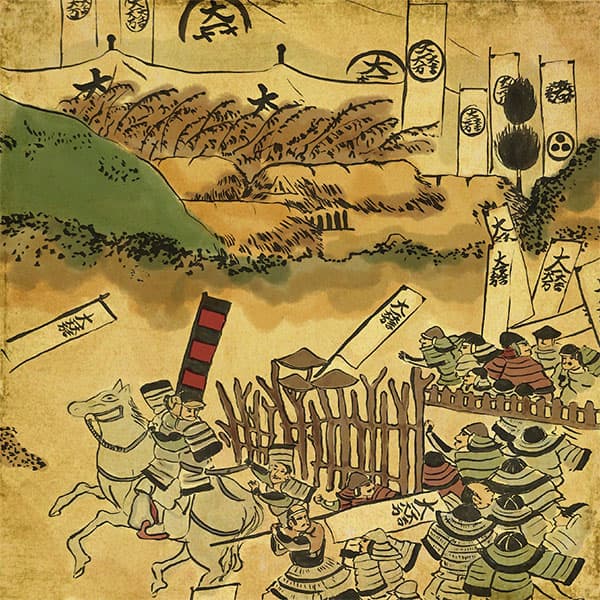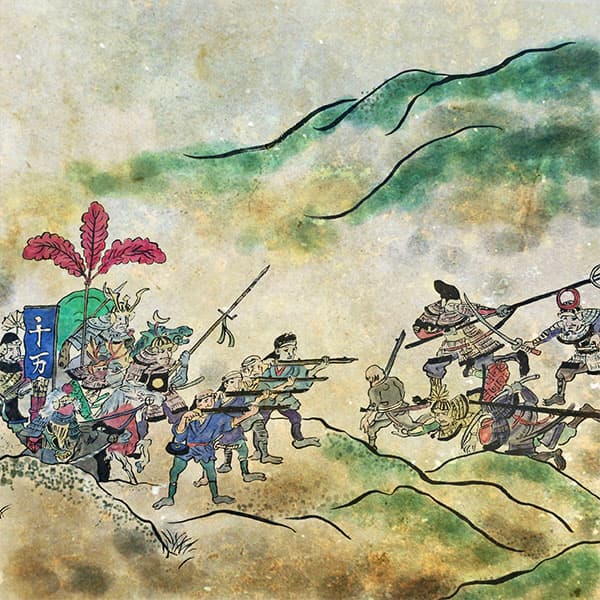Tadakatsu Honda (1/2)A military commander who has both flowers and fruits and is highly rated by everyone.

Tadakatsu Honda
- Article category
- biography
- name
- Honda Tadakatsu (1548-1610)
- place of birth
- Aichi prefecture
- Related castles, temples and shrines

Kuwana Castle

Otaki Castle
- related incident
Long ago, samurai ran around Japan. The last time the samurai were active was the Edo period, which lasted for 250 years. Tokugawa Ieyasu established the Edo Shogunate. Tokugawa Ieyasu's life was full of hardships from an early age, but in the end he became a ruler of Japan. When Ieyasu was young, people around him said that he had things that were considered too much (possessions unsuitable for him). That is the phrase ``Honda Heihachi at the head of the Tang Dynasty''.
Tang's head is the hair of an animal called yaku that lives on the Tibetan plateau, and was called ``Tang's head'' because it was brought from China. It was a particularly valuable imported item at the time, and it is said that Ieyasu wore it as a decoration on his helmet.
Another Honda Heihachi is the main character of this article, Honda Heihachiro Tadakatsu. Honda Tadakatsu was an extremely skilled fighter and participated in 57 battles, large and small, during his lifetime. It is said that he never got hurt in those 57 times.
Tadakatsu has saved Ieyasu from many difficult situations. Now, I would like to introduce you to the kind of person Honda Tadakatsu was.
From the birth of Honda Tadakatsu to his youth
Honda Tadakatsu was born in 1548 as the eldest son of Honda Tadataka in Kuramae, Nukata District, Mikawa Province (Nishikuramae Town, Okazaki City, Aichi Prefecture).
The Honda family was the oldest Ansho Fudai of the Ansho Matsudaira family (Tokugawa main family). There are seven families in the Ansho Fudai: Sakai, Okubo, Honda, Abe, Ishikawa, Aoyama, and Uemura. Tadakatsu was born into the Honda family.
At that time, the Matsudaira clan in Mikawa was sandwiched between the Imagawa family to the east and the Oda family to the west. As a result, the samurai of Mikawa were suffering. Honda Tadakatsu's father, Tadaka, also died in battle in 1549. Tadakatsu was raised under his uncle Tadazane Honda.
Honda Tadakatsu served Tokugawa Ieyasu from an early age, and in 1560, at the age of 13, he fought for the first time at Otaka Castle, a prelude to the Battle of Okehazama. Later, when Ieyasu became independent from the Imagawa family, he participated in the ``Mikawa Ikko Ikki'' and the ``Siege of Kaminogo Castle'' and ``Siege of Ushikubo Castle.''
Through these battles, Tokugawa Ieyasu discovered Honda Tadakatsu's abilities as a general. In 1566, at the age of 19, he was selected as a hatamoto sante. He entrusts 54 cavalry to Tadakatsu as his subordinates. From then on, he always lived near Ieyasu's castle and played an active role as a general of the hatamoto force.
In 1570, he also participated in the Battle of Anegawa, a battle between the Oda and Tokugawa families and the Asai and Asakura families. In this battle, Honda Tadakatsu made a name for himself in a one-on-one combat with Jurozaemon Magara, a mighty member of the Asakura army.
At the request of Oda Nobunaga, the Tokugawa family has been fighting against the Takeda family for many years, providing reinforcements.
Honda Tadakatsu participated in the ``Battle of Mikatagahara'' as a general, and immediately after the battle, he launched a night attack on the Takeda army encamped at Saiga Cliff, throwing the Takeda army into chaos. It also participated in the Battle of Nagashino and the Battle for the Recapture of Takatenjin Castle.
Although Honda Tadakatsu was on Ieyasu's side, he was always on the scene of battles for the Tokugawa clan and continued to fight.
In 1582, the Honnoji Incident occurred and Oda Nobunaga died.
At this time, Ieyasu was staying in Sakai with a small entourage including Tadakatsu Honda. When Ieyasu learns of Nobunaga's death in the Honnoji Incident, he becomes distraught and tries to go to Kyoto to follow Nobunaga, but Tadakatsu admonishes him. Then, they decided to make the ``Iga crossing'', avoiding Kyoto and returning to Mikawa by crossing Iga.
On this journey, we finished passing the boat at Kizugawa River.
It is said that he used the butt of a spear to pierce the bottom of the ship after it had been delivered, preventing pursuers from using it. Tadakatsu's instincts about the war turned into his actions of being cautious and cautious.
In April 1584, Honda Tadakatsu was initially assigned the duty of guard during the Battle of Komaki and Nagakute, fought between the Tokugawa and Toyotomi families. However, upon hearing that Tokugawa Ieyasu was struggling and crumbling in front of Toyotomi's 100,000-strong army, Tadakatsu rushed from Komaki with just 500 soldiers.
Surprisingly, they stood five towns (approximately 500 meters) in front of Toyotomi's large army, blocking the advance of Toyotomi's army.
It was a reckless act out of Tadakatsu's loyalty, but he acted for Ieyasu with the determination to destroy him.
In this way, Honda Tadakatsu was at the forefront of the Tokugawa family from his first battle through his youth and into his prime. The battlefield is Tadakatsu's place of growth and workplace. The experience he gained there honed his intuition regarding warfare, and he became like a master.
In 1590, when Tokugawa Ieyasu was transferred to the Kanto region, he was given 100,000 koku in Otaki, Isumi District, Kazusa Province (Otaki Town, Isumi District, Chiba Prefecture).
This placement of Honda Tadakatsu was in preparation for the Satomi clan in Awa Province (present-day Boso Peninsula, Chiba Prefecture).
Therefore, in order to prevent the Satomi clan from moving north, Tadakatsu carried out a sudden construction project, majorly renovated the castle into an early modern castle with a three-layer, four-story castle tower, and built a castle town at the foot of the castle. This is the beginning of today's Otaki Castle.
In this way, Tadakatsu also changes from the battlefield to a position that requires a broader perspective.
Evaluation of Honda Tadakatsu
Honda Tadakatsu carried one of Japan's three most famous spears, Tonbo-kiri, and went into battle wearing a deer-shaped helmet. And he is fighting on the front lines of the Tokugawa family's battle more than anyone else. Therefore, it was evaluated by various people.
The generals under Tadakatsu Honda were praised, saying, ``Fighting under Tadakatsu's command is like carrying a shield on your back.'' Tadakatsu made sure that he could focus only on the enemy in front of him without worrying about what was behind him.
Tadakatsu served as a lord at the Battle of Hitotokozaka, which was a prelude to the Battle of Mikatagahara.
Due to his fighting style, his enemy, Sakon Kosugi of the Takeda army, is said to have praised him, saying, ``There are two people who are better than Ieyasu, and the head of the Tang Dynasty is Heihachi Honda.''
As mentioned at the beginning, the ``Tang head'' refers to Ieyasu's use of the hair of rare animals from China to decorate his helmet. The name ``Honda Heihachi'' is taken from Tadakatsu's common name ``Heihachiro,'' and he was praised by his enemies as a military commander who was too good for Ieyasu.
Tadakatsu's bravery became known even to the Takeda army, as he remained on the battlefield in a disadvantageous situation due to the retreat of his master, and even succeeded in escaping himself despite his determination to die.
Oda Nobunaga, the ruler of the era, borrowed the power of the Mikawa samurai many times for his allied forces, and among them he praised Honda Tadakatsu as ``a military commander with both flower and fruit.''
Toyotomi Hideyoshi, who became ruler of Japan, fought with Tokugawa Ieyasu sometimes as an ally and sometimes as an enemy. For this reason, I watched Honda Tadakatsu's work more than anyone else and said, ``Just as there is an unparalleled general in the East named Tadakatsu Honda, in the West there is an unparalleled general named Muneshige Tachibana.'' As a military commander, I cited him and evaluated him.
Naturally, he was highly praised by his master, Ieyasu, who praised him, saying, ``He is truly a good commander of our family.''
There is also a senryu poem about Tadakatsu that says, ``When a dragonfly appears, it scatters the spiderlings.A dragonfly in his hands, and the horns on his head are fierce.It's a helmet that makes it hard to tell if it's a demon or a human.''
There are not many military commanders who are praised by so many people.
After the Battle of Sekigahara
When Toyotomi Hideyoshi, the ruler of Japan, died, Tokugawa Ieyasu set his sights on taking over the country.
When the Battle of Sekigahara occurred in 1600, Honda Tadakatsu joined Ieyasu's main army.
However, Honda's main army was commanded by his eldest son, Tadamasa, and it is said that Tadakatsu was at the Tokugawa main camp, waiting close to Ieyasu. At this time, Tadakatsu sent a letter co-signed with Naomasa Ii, urging the Tokugawa side to defect. He fought hard in the main tournament and achieved 90 titles with only a small number of players.
As a result of this achievement, in 1601, he was appointed to Kuwana, Ise Province (present-day Kuwana City, Mie Prefecture) with 100,000 koku. This meant that Hideyori Toyotomi of Osaka left this task to Tadakatsu Honda, who trusted Kuwana, which was an important point on the Tokaido. In addition, the former territory of Otaki was given to his second son, Tadatomo, at a cost of 50,000 koku.
However, in the 9th year of Keicho, he became ill and requested to retire, but at that time Ieyasu stayed behind.
Later, in 1609, he suffered from an eye disease, and in June 1609, he handed over the headship of the family to his eldest son, Tadamasa, and retired.
However, the following year, on October 18, 1610, he died in Kuwana. He passed away at the age of 63.
On his deathbed, Honda Tadakatsu said, ``A samurai does not retreat in the face of adversity, even if he does not take the head or is at fault.He is called a samurai because he stands side by side with his master and dies in battle, defending his loyalty.'' I am leaving behind. These are the words that describe the life of Tadakatsu, who was loyal to only Tokugawa Ieyasu.
Honda Tadakatsu and Kuwana Castle
Honda Tadakatsu died in Kuwana in 1610. So, what was Kuwana, the place where Tadakatsu died?
- related incident

- WriterTomoyo Hazuki(Writer)I have loved history and geography since my student days, and have enjoyed visiting historical sites, temples and shrines, and researching ancient documents. He is especially strong in medieval Japanese history and European history in world history, and has read a wide range of things, including primary sources and historical entertainment novels. There are so many favorite military commanders and castles that I can't name them, but I especially like Hisashi Matsunaga and Mitsuhide Akechi, and when it comes to castles, I like Hikone Castle and Fushimi Castle. Once you start talking about the lives of warlords and the history of castles, there's a side of you that can't stop talking about them.









